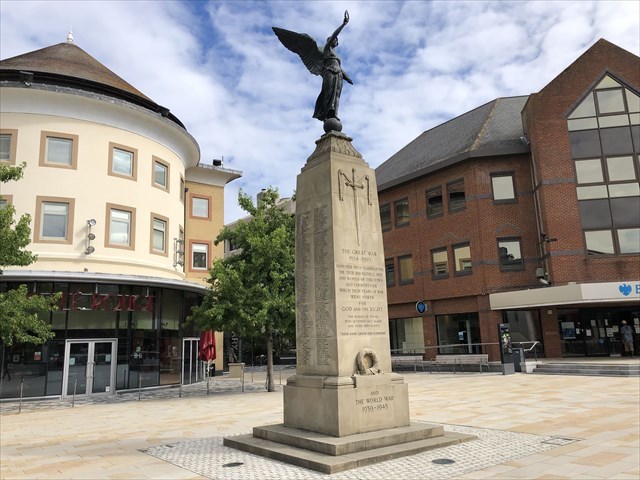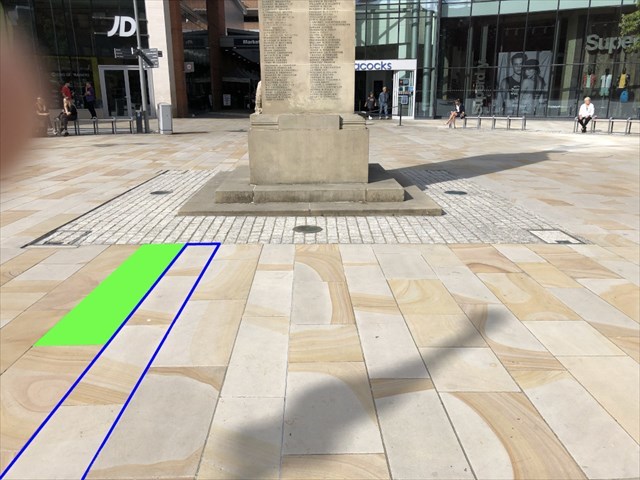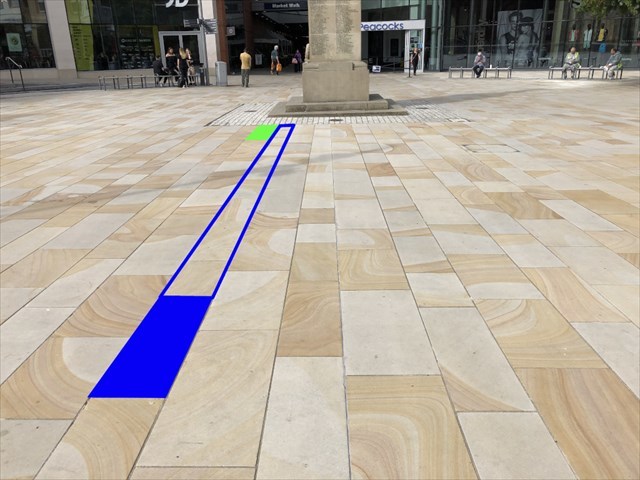I have positioned the posted coordinates to the rear of the War Memorial so that the EarthCache icon does not obscure the existing icons for the nearby puzzle caches.
Since the cache is an EarthCache, there is no physical container to search for at the coordinates or around the area of the war memorial. Instead, you will need to look at the geology of the paving slabs adjoining the war memorial and answer a few simple questions set out below.
FIRST THE WAR MEMORIAL

The original war memorial in Woking was erected as a permanent testament to the sacrifice made by 552 members of the local community who lost their lives in the First World War. The sandstone war memorial was built by Messrs William Kirkpatrick with the bronze statue by the sculptor Francis William Doyle Jones. It was located in Victoria Garden and unveiled on 24 May 1922. An inscription dedicated to those who lost their lives in the Second World War war was added by the London Necropolis Company in 1950.
The memorial was relocated to the current location in the Town Square (now known as Jubilee Square) in 1975.
NOW THE GEOLOGY
Sandstone is a sedimentary rock made mainly from rock fragments (sediments) which were deposited in horizontal layers and held together by mineral cement. Sandstones can be found in many colours including grey, brown, red and yellow and it is often possible to identify bedding planes which occur when layers of sediment with different particle sizes are deposited on top of each other. These beds can range from millimeters thick to several meters thick.
Liesegang bands or rings are coloured bands that have cut-across the bedding planes of certain rocks. They are a form of iron staining produced through a series of complex chemical reactions in ground waters percolating through the rock although the exact process by which they are formed is not certain and is still being studied by geologists. It is however generally accepted that they do not form during the original deposition of the sediments but at some later point in time. They are more commonly found within sedimentary rocks but occasionally similar looking features can also be found in igneous and metamorphic rocks.
The war memorial is surrounded by paving slabs cut from sandstone. If you look at the paving slabs you will notice that they have some visually stunning colours and patterns. Somehow minerals have become concentrated in the sandstone and arranged into numerous regular repeating concentric patterns and bands in distinct shades of reds, oranges, yellows and browns. These are Liesegang bands. In this instance they got their colouring from the ferrous minerals they were made from ie iron oxides. Darker bands indicate higher concentrations of iron oxides and lighter coloured bands indicate lower concentrations. Sometimes the bands can form from other metals.
You will notice that each paving slap has a different pattern although generally they comprise a series of parallel repeating bands. Sometimes Liesegang bands may form as regular concentric circles although rings of various shapes can occur. Sometimes they form near-perfect cylinders that resemble iron pipes, or spirals and spheres which are oriented in various directions. They are sometimes described as being similar to tree rings but unlike tree rings the number of rings does not determine the age.
To answer the questions below, please go to the side of the war memorial which has the name SYDNEY W ACOCK at the top. Stand with your back to the war memorial and you should be able to locate the paving slabs shown in green in the photo below.

Q1 Please describe the patterns and shapes shown on the paving slabs coloured green in the photo. Are they random, repeating, concentric, jagged, uneven? Are the bands clearly defined? Please describe any examples of complete Liesegang rings.
Q2. Please describe the colours of the bands and explain why they vary. Do the colours gradually become darker or lighter or is the effect more random? What do the darker colours indicate? What mineral do you think is responsible for the colours of the banding?
Now please go to the centre of the other side of the memorial that has the name WILLIAM JOHN GODFREY at the top. Stand with your back to the war memorial and you should be able to locate the paving slab shown in red in the photo below.

Q3. Please describe the patterns on this paving slab in terms of clarity and colour range comparing them with the patterns on the slabs at the previous location and confirm whether there any clearly defined bands or rings. Please suggest a reason why the patterns in this slab are different.
Now please go back to the first side of the war memorial (SYDNEY W ACOCK) and stand with your back to the war memorial. Please walk down the row of paving slabs shown edged in blue in the photo below and look at the 9th paving slab down the row. This paving slab is coloured blue in the photo.

Q4. Please describe the differences in terms of colours and patterns between this paving slab and the previous ones that you have looked at. Please explain, giving reasons, whether you consider these patterns to be characteristic of Liesegang bands and rings.
BEFORE LOGGING THIS EARTHCACHE, please use the message centre or email me with your answers to the questions above. Please include the GC number and cache title. Please do not put the answers in your log.
I hope you enjoy my EarthCache and good luck with the answers.
***** PLEASE NOTE IMPORTANT *****
CACHES ARE NOT ALLOWED TO BE PLACED ON ACTUAL MEMORIALS OR WITHIN THE BOUNDARY OF SUCH
AT ALL TIMES PLEASE TREAT LOCATIONS OF MEMORIALS WITH RESPECT